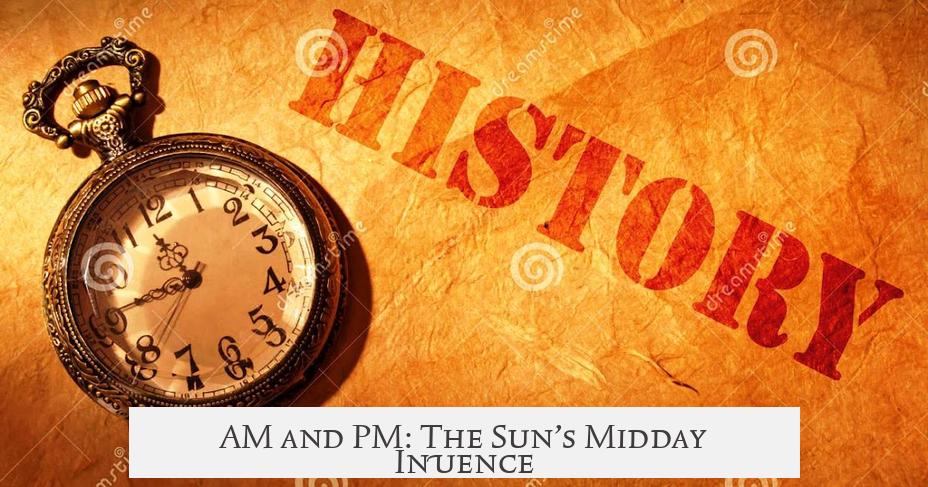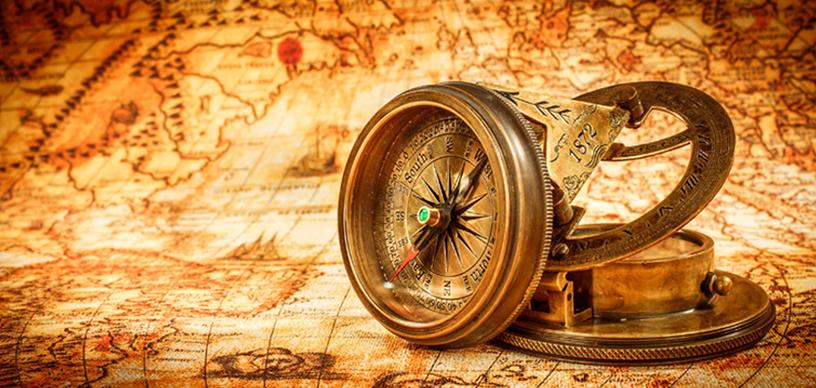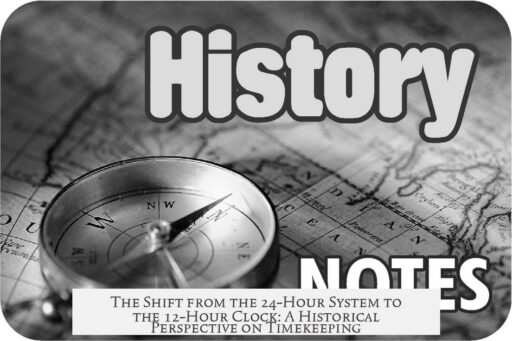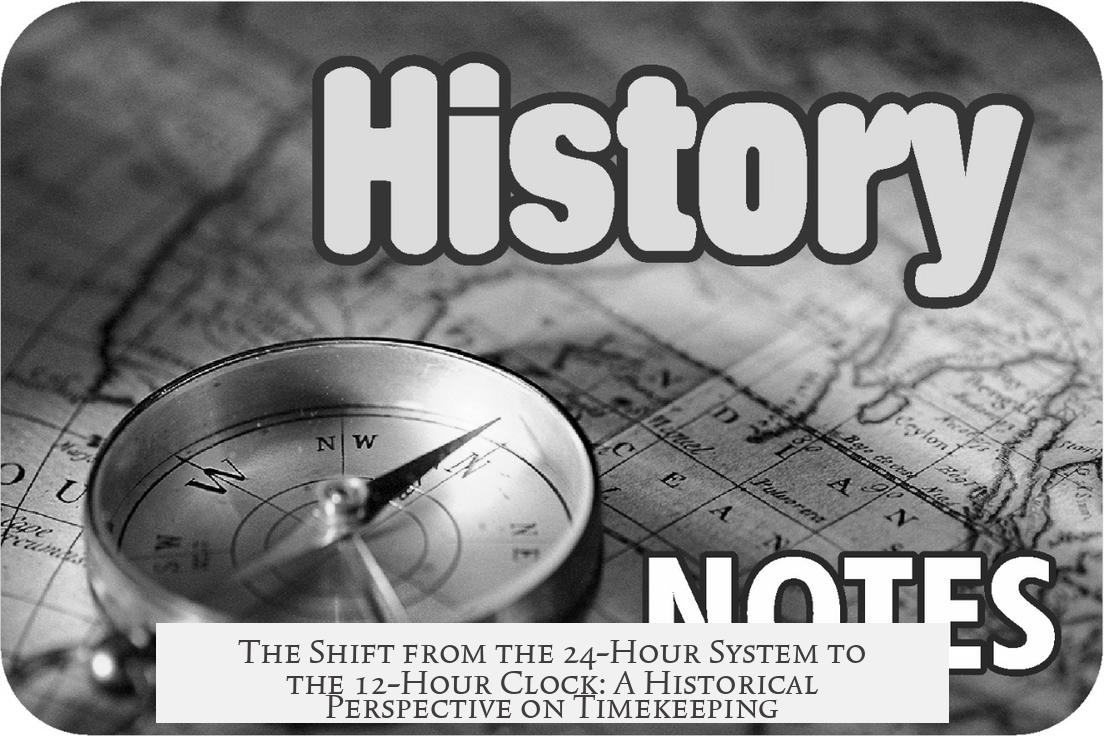The use of the 12-hour clock over the 24-hour system originated from ancient traditions and practical aspects of early timekeeping methods. The 12-hour clock traces back to Mesopotamian and Egyptian sundials, which divided the day into two periods of 12 hours, reflecting daylight and nighttime portions. Romans continued this tradition, embedding the 12-hour cycle in daily life.
The AM/PM notation arose to distinguish between the ante meridian (before midday) and post meridian (after midday) periods. This division linked closely to the sun’s position, with midday marking the point when the sun is highest, simplifying the daily cycle.
While the 24-hour system existed, especially for astronomical purposes, it initially remained limited to specialized use. The 24-hour day was sometimes split into two 12-hour periods even in those contexts.
The shift from 12-hour to 24-hour timekeeping hinged on advancements in mechanical clocks, which surfaced in the 14th century. Prior to this, time during daylight and darkness was split into 12 temporal hours, whose lengths varied with the seasons. Sundials adapted well to this variability, but mechanical clocks required fixed hour lengths. By the late 15th century, Europe largely adopted the modern concept of 24 fixed hours, influencing both clock technology and sundial design.
Medieval customs also influenced time perception. Days frequently began in the evening rather than at midnight, affecting cultural events and prayer schedules, such as evening prayers at 7 PM and early morning prayers at 2 AM.
The choice of 12 as the hour count does not perfectly align with the sun’s highest point, which often occurs slightly after 12 noon on sundials. This discrepancy highlights the origins of the system as more symbolic and practical than astronomically precise.
Geographically, the 12-hour clock is most common in English-speaking countries like the United States. Elsewhere, especially in Europe and many non-English-speaking regions, the 24-hour clock system remains prevalent for clarity and uniformity.
- The 12-hour system started with ancient sundials and was popularized by Romans.
- Mechanical clocks in the 14th century initiated a shift towards the 24-hour system for fixed hours.
- AM/PM divisions relate to the sun’s highest point, aiding daily timekeeping.
- Medieval practices influenced how days were counted and structured around evening starts.
- Geographical usage varies; 12-hour clocks dominate in English-speaking countries.
Why Did People Start Using the 12-Hour Clock Instead of the 24-Hour System to Denote Time?

The answer is rooted deeply in history and simplicity: people started using the 12-hour clock because it was tied to natural, easily observable daylight cycles, making time simpler to understand before advanced technology made continuous counting practical. Let’s dive into the sundials of ancient civilizations, medieval quirks, and mechanical clocks to see why the 12-hour system became the dominant way to keep time.
Imagine ancient times—no smartphones, no atomic clocks, just the sun and shadows. The original 12-hour clock traces way back to Mesopotamian and Egyptian sundials. These early timekeepers divided the day into two sets of 12 hours corresponding roughly to daylight and darkness.
This wasn’t some random number—the Egyptians loved the number 12 because it represented both practicality and balance. The day was split into 12 hours of daylight and 12 hours of night, though the length of these “hours” actually varied depending on the season. This is why timekeeping before mechanical clocks was flexible, adapting to sunlight rather than a rigid structure.
AM and PM: The Sun’s Midday Influence

Why “AM” and “PM”? These terms spring from Latin —ante meridiem (before midday) and post meridiem (after midday). This made perfect sense: the sun reaches its highest point roughly in the middle of the day, a natural divider that anyone could observe. It’s like Mother Nature’s way of saying, “Hey, this is noon, split your day in half.”
So, if you think about it, the 12-hour clock is kind of an ancient “sun dial” smartwatch. It was practical for everyday life because it mirrored the natural rhythm of daylight. Easy to grasp, no need for fancy math or counting continuously beyond 12.
The 24-Hour System: Counting the Night

But what about the 24-hour clock? It’s true, the 24-hour system exists and makes a lot of sense, especially for people in northern or southern regions where daylight hours change drastically. The 24-hour cycle divides a full day and night into one continuous count from 0 to 24.
Historically, though, the 24-hour system initially existed only in astronomy and scientific circles. Early 24-hour time was still split into two cycles of 12 hours—the concept of a single, relentless 24-hour count was not widely practical until technology caught up.
The Mechanical Clock Revolution

Enter the 14th century and the birth of the mechanical clock, a game changer. Mechanical clocks could keep a constant, reliable pace, no longer fluctuating with daylight hours like sundials.
Now people could start measuring time in fixed, equal hours—say hello to the modern 24-hour system! Actually, it’s more complicated. Before this, people divided their days and nights into 12 “variable” hours each, with lengths changing by season. Mechanical clocks delivered standard hours, consistent through the day and night.
It took until the late 15th century for Europe to mostly accept this new way. Interestingly, sundials themselves had to adjust, no longer changing hour lengths with the seasons but sticking to fixed hours corresponding with the mechanical clocks.
So the shift from 12 to 24 hours was driven by technological advances that enabled precise and consistent measurement. But here’s the kicker: even though mechanical clocks paved the way for the 24-hour system, the 12-hour clock stuck around for casual use.
Medieval Oddities: When Does a Day Start?

Want to spice things up? The official start of a day was once considered to be in the evening, not midnight. This explains odd celebrations like Christmas Eve holding a big significance—because culturally, the “day” begins at sundown.
By medieval standards, a day’s first prayer could be at 2 AM, the last at 7 PM. This religious and cultural influence kept the 12-hour system relevant and meaningful in daily life, emphasizing day-night cycles tied to human activities and the sun’s path.
Curious Case of Noon: Why 12 PM Doesn’t Always Fit
Here’s a puzzler for you: technically, 12 PM should be when the sun hits its highest point, but a sundial shows sometimes noon falls around 12:30 or even 1 PM. Why? The earth’s orbit and seasonal shifts mess with our rigid time divisions.
This exposes a fundamental quirk—the 12-hour clock is a convenient human construct, not a perfect solar tracker. It smooths out natural irregularities to keep life tidy.
Geographical Note: Is the 12-Hour Clock Universal?
You might wonder if the 12-hour system is global. Interestingly, many cultures worldwide use the 24-hour clock or variations tuned to local customs. Outside English-speaking countries, 24-hour time, often called “military time,” is more common.
For example, in Iceland, where daylight fluctuates hugely across seasons, the 24-hour clock is the norm. Moving to the USA, many people discover the 12-hour system feels natural but not universal.
Why Does the 12-Hour Clock Persist?
- Simple and familiar: It divides the day where daylight makes sense—before and after noon.
- Cultural inertia: Centuries of use embed it deeply into social routines and language.
- Practical for everyday life: For casual conversation and scheduling, halves of the day are easier to picture than continuous counting.
But don’t get me wrong. Both systems have their merits. The 24-hour clock shines in transportation, military, and science where avoiding confusion is critical. Meanwhile, the 12-hour system feels homely and easy on the brain.
Final Takeaway
So, why did people start using the 12-hour clock instead of a full 24-hour system? Because it matches human perception of the day split by the sun’s cycle, made sense before precise clocks existed, and fit cultural and religious frameworks. When accurate timekeeping emerged, the 24-hour system took hold in specialized fields, but the 12-hour clock stuck around—in kitchens, conversations, and calendars.
Next time you check your watch and see “7 PM,” you’re tapping centuries of tradition that began with shadows on ancient sundials.




